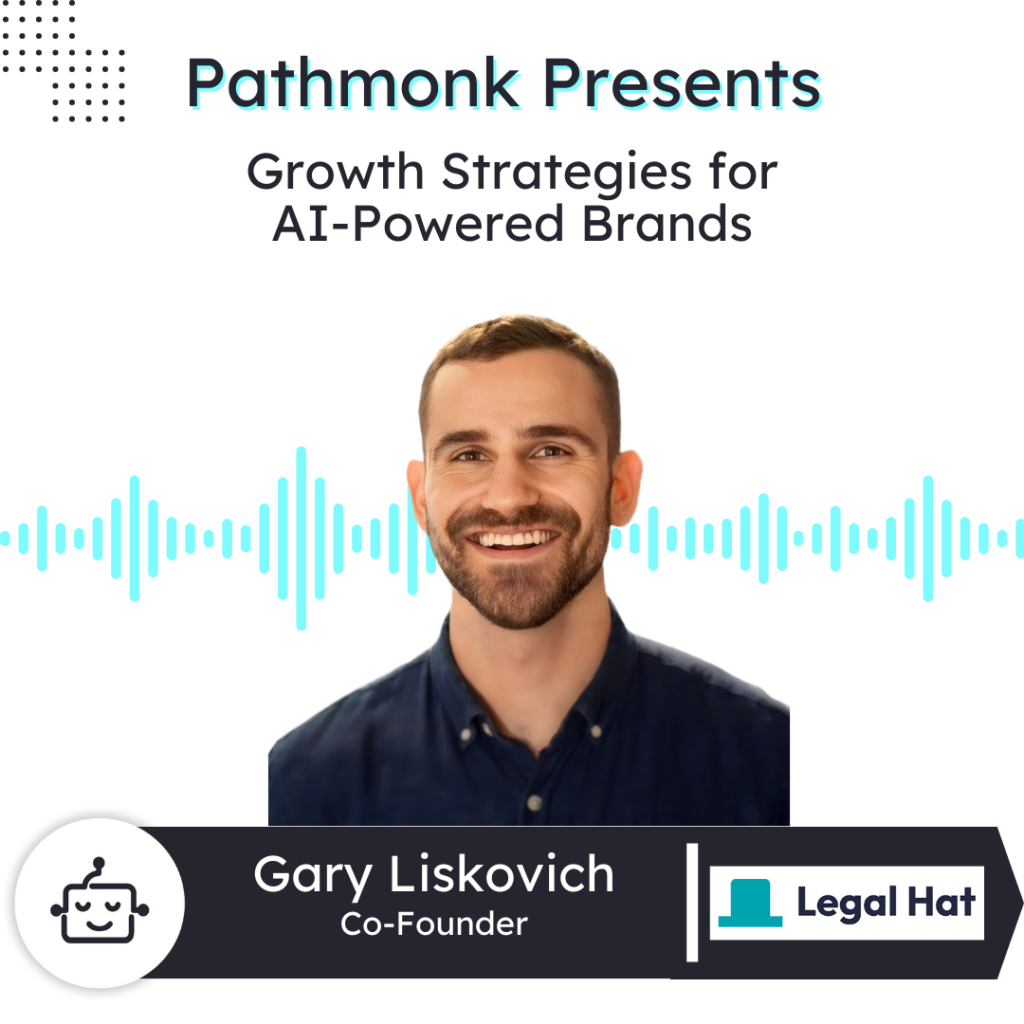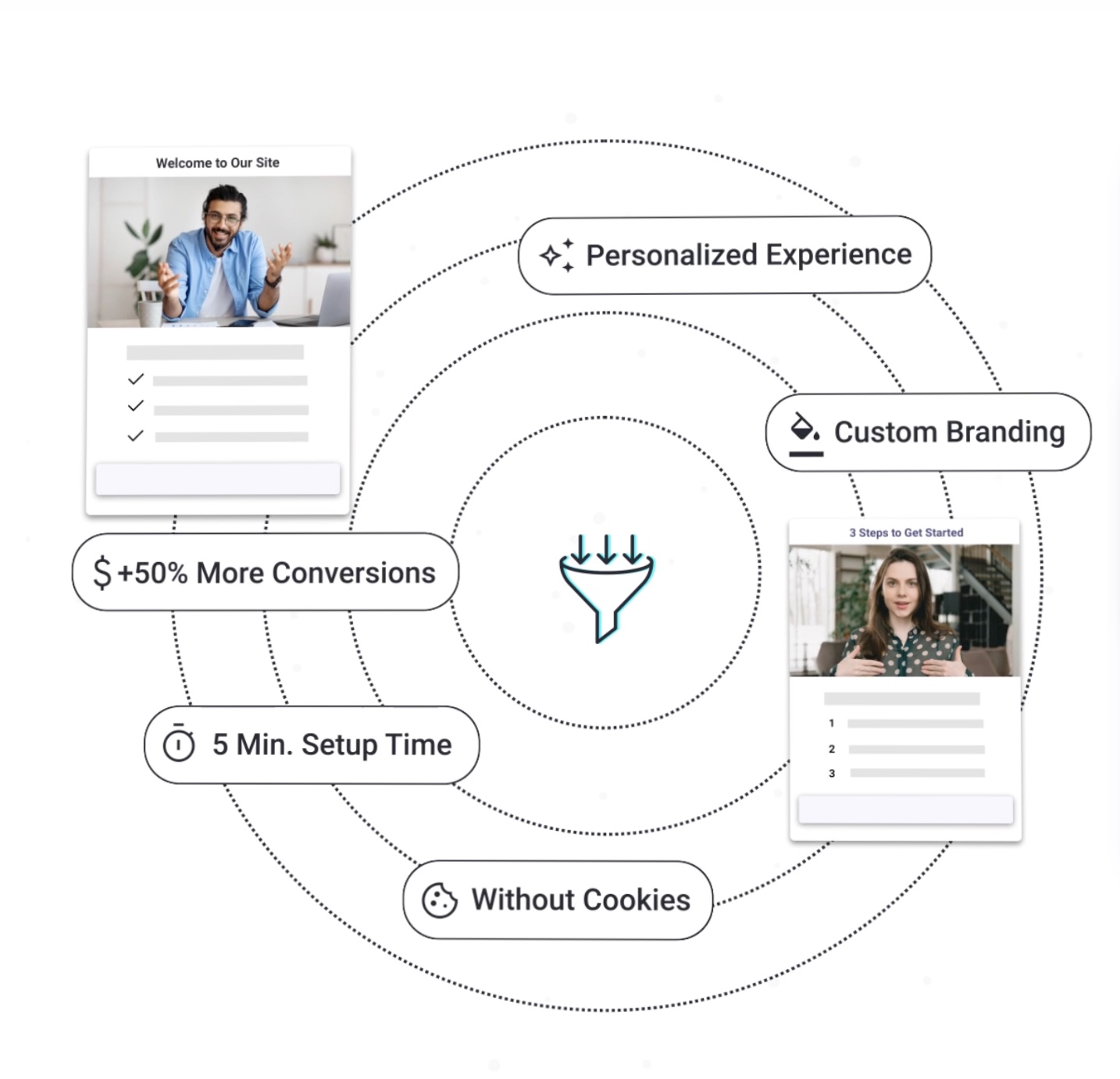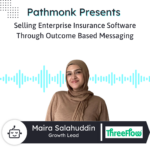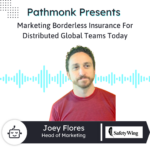
Introduction
Gary Liskovich, co-founder of Legal Hat, discusses how their AI agents are revolutionizing legal and compliance tasks for businesses. Legal Hat focuses on automating the “last mile” of legal operations, particularly for non-legal professionals who often handle legal work.
Gary shares insights on customer acquisition strategies and the importance of consistent storytelling in building a brand. It highlights their focus on automating complex legal processes for non-legal professionals, their success in specific industries, and their strategies for customer acquisition and brand building in the innovative legal tech space.
Don’t miss out on this unique episode!
More Sales From Your Website With AI
Personalized interactions based on your users' behaviour to get +50% more conversions.

Ernesto Quezada: Pathmonk is the intelligent tool for website lead generation. With increasing online competition, over 98% of website visitors don’t convert. The ability to successfully show your value proposition and support visitors in their buying journey separates you from the competition online. Pathmonk qualifies and converts leads on your website by figuring out where they are in the buying journey and influencing them in key decision moments. With relevant micro experiences like case studies, intro videos, and much more, stay relevant to your visitors and increase conversions by 50%. Add Pathmonk to your website in seconds. Let the AI do all the work and get access to 50% more qualified leads while you keep doing marketing and sales as usual. Check us on pathmonk.com. Welcome to today’s episode. Let’s give a good welcome to Gary from Legal Hat, co-founder with them. How are you doing today, Gary?
Gary Liskovich: Doing great. Happy to be here.
Ernesto: It’s great to have you on and, well, I’m sure our listeners are tuning in, wondering what Legal Hat is all about. So, let’s kick it off with that. In your own words, can you tell us a little bit more?
Gary: Absolutely. So we at Legal Hat are building AI agents that help automate legal and compliance tasks for businesses. When people hear about legal, I like to double-click a little bit there. The way we see legal are three main types. So there’s the legal that are handled by outside firms. You know, you will hire a firm to do some kind of litigation for you and all other really intense work. Some businesses have the second bucket, which is in-house counsel, and then the third bucket, which actually makes up the majority of legal tasks that are done within businesses, is not even done by lawyers, whether internal or external counsel. And that’s what we’re focused on, essentially helping all the people that aren’t trained to do legal work, don’t want to do legal work, have other responsibilities, but somehow end up doing all of that work at organizations. We’re helping them automate it with AI agents that are really specific on certain tasks and nuanced and understand the business itself.
Ernesto: Definitely. I think there are companies out there and a couple of salespeople and operations, customer success as that, you know, at one point, you know, they got that little burden. So awesome to hear that. Yeah, so that way our listeners could get a good understanding here of Legal Hat then, Gary, I mean, you mentioned, but is there like that key problem? Would that be the key problem that you guys like to solve for clients?
Gary: Yeah. So we are doing the last mile on legal operations work. So classic example being there’s so much information trapped in contracts. And maybe you have lawyers doing incredible legal strategy, putting together a contract to safeguard all the parties in an agreement. Now, once that is signed, you ask anybody, what happens is they forget about the contract immediately. All that work that the lawyers did, all those protections, all that really creative work done gets lost. And what is meant to be done is that legal contract is meant to be a strategy of sorts, right? It’s meant to be, let’s make sure we have touchpoints and regulations and have protections in there. So what we do is we use AI to unpack that contract and then reach out and make sure that everything within the contract is being followed appropriately. Naturally, that lends us to more of the complex organizations. Not so much a mom and pop shop, but organizations that have complex and bespoke contracts with other business entities.
Ernesto: All right, awesome. So then, as far as some clienteles, is there a vertical segment? Is there an ideal ICP for you guys?
Gary: So we’re in a few industries. The focus is naturally businesses that have repetitive, complex legal tasks. So you’re doing a lot of them. They’re not repeatable, but they’re different every single time. So because of that, we’re focused on three main ones, technology services, because B2B SaaS, a lot of negotiations happen there. But the data privacy and other elements, we’re also in construction and manufacturing just because they have a lot of services that are related, where there’s project management tools in there in the contract, and a lot of nuances baked into that. The third is the one that we’re really expanding and growing fast in is in franchising. And franchising is pretty interesting in that. I don’t know how much you know about it, but it’s kind of one central entity, which is the franchisor. And they really quickly bridge out to hundreds, sometimes thousands of what’s called franchisees. So because of that relationship, you have two business entities with a whole lot of legal protections and operation manual, and a lot of structures baked in. And it’s very, very, very hard to enforce or understand or get visibility into how the two businesses are operating, even though they’re meant to be lockstep. So what we’re building is tools that unpack those contracts into a list of things that are required of both parties, and then goes out and pulls that information and verifies it with no intervention from people. So it’s on autopilot for everybody, and they can get back to their craft.
Ernesto: Okay, nicely done. All right, perfect. Awesome. So then, I mean, what would you say then, is a top client acquisition channel for Legal Hat?
Gary: So right now, it’s a lot of in-person. We are a young company, right? We’re not a household name yet. Because of that, a lot of our acquisition is meant to be face-to-face, getting to conferences, meeting the folks, but then also really relying on our referrals. And referrals can come from previous customers or existing customers, from their advisors. We meet consultants that advise those potential customers and make sure that they understand our value. And then also advisers of Legal Hat. We do a fair bit on some social media, but the referral network has been the primary.
Ernesto: Okay, awesome. And so that way, when the listeners who are tuned in could go ahead and visit you guys, they could always check you out at Legal Hat. What role does the site then play for client acquisition, Gary?
Gary: Sure. So I think that our website is incredibly important. If you think about B2B sales, you’re talking to the customer. And a lot of this conversation based in the absence of me being in the room, which is most of the time, there’s only, you know, there’s a primary place for where you go to learn about Legal Hat. And, you know, if my potential buyer is trying to check out Legal Hat, they will go to legalhat.com. And it’s kind of like a take-home one page on what we are as a business. So with that, I think it’s really important that our website and the narrative I tell customers, investors, everybody is consistent. And in that way, because it’s the constant public-facing part of the business, it is kind of that grounding element in our messaging and our value.
Ernesto: Very great. And so on that note, then, is there any tools or tips or methods that you would recommend to our listeners as far as some website lead generation?
Gary: Sure. We try to make sure that this is true for the website, but this is true for, I think, every interaction, which there has to be a positive interaction at every part of the website. Just like when you’re talking to someone, that you want them to have a positive impact. And that can take a whole range of forms. First, it can be informative, teach them something new. That can be true for an interaction that could be true for a website. It could be something that’s customized and really makes them feel heard as an audience. Again, true for both channels. Interactivity, where you’re asking questions or asking them for input and reacting to it. And it could be something as simple as just being visually pleasant or conversational in other parts, but it’s kind of the ability to make sure that it’s a pleasant interaction, informative, or makes them feel good at every step of the way.
Ernesto: Great to hear that from you, Gary. And, well, let’s switch gears a little bit then, and let’s talk about you as a leader. You being the co-founder there for Legal Hat, what are some key tasks you like to focus on your day-to-day work?
Gary: So I would say I spend a good portion of my day storytelling. And the reason is, early companies, a lot of it is forming the vision. And the vision comes from working with my co-founders or our customers. And with our customers, a lot of the storytelling is trying to tell their story back to them to make sure I heard them right. Talking to employees, investors. So a lot of what I spend my day on is either telling the story of Legal Hat, telling the story where Legal Hat will go, but also kind of tweaking it to the, you know, a lot of the people around me and kind of their input. So that said, right, a lot of my day is meetings, naturally, meeting with potential customers, investors, and the like. And then a lot of it is, you know, the written communication, whether it be our website or email, making sure that that story that we’re telling or crafting and you’re changing along the way, that that story is being consistent and that everybody has a say in it. So a lot of that is crafting the narratives into whatever channel I’m using for it.
Ernesto: Absolutely important. And in between those times, then, Gary, is there a preferred channel that you like to go with to stay updated with all the marketing trends, strategies, going out there?
Gary: Yeah, I would say I do spend some time on Twitter and LinkedIn. I would say that there are specifically on those two channels, there are a lot of folks that largely I’ve met, I’ve connected with over the past few years that I follow. And I like to check in on what they’re reposting and then posting, but also where they’re commenting. I think that there’s a lot of insight seeing where different people in my network are, what kind of conversations they’re engaging, and then that leads me to an interesting person I’ve never heard before. And something that they are posting. And I think this is a great way to consume content, is not just listening to what people say in a more posting forum, but also what people are saying in a comment and a sub-thread.
Ernesto: Definitely. Okay, that’s awesome. Thank you so much for sharing that with our listeners. And, well, let’s jump into our next section then here, Gary, which is a rapid fire question round. Are you ready for them?
Gary: Sure.
Ernesto: Awesome. Then, Gary, first off then is, what is the last book that you read?
Gary: I just finished Exhalation by Ted Chiang. It’s a series of short stories. And it’s pretty cool. I mean, they’re all a little Sci-Fi-ish. But rather than being more about a narrative, I think he crafts short stories that are crafted around an idea. So it’s kind of, let’s explore an idea, and then he’ll craft the narrative around it to kind of bring it to light and make it easier to engage with. I thought it was great.
Ernesto: Definitely. Okay, great read there for our listeners. Next up then is, if there would be no boundaries in technology, what would be that one thing that you want to have fixed for your role as a marketer today?
Gary: I think there’s a lot of noise in all marketing channels for the most part. I don’t know how one could do this. But I would love to understand, you know, when I’m interacting with a stranger, I’d love to understand what their expertise is in a subject. A lot of people are self-described experts. And, you know, they, oftentimes they say brilliant, awesome things. And sometimes I think some things they say might be misleading. And then on the flip side, I think some of the folks that might not have the accolades or the other, you know, not so great proxies that we take for being a strong voice have really awesome, insightful things to say. We don’t give them the platform. So I wish there was some way to kind of flatten that and say, like, who’s actually spent a lot of time researching and thinking about this, regardless of whatever different proxy or accolades and awards and speaking engagements they’ve had in the past, like, who’s actually thought about this subject? Ah, void of that. So I’d love for that to be kind of a separate score of how much people have invested in the subject. But, yeah, wishful thinking.
Ernesto: Yeah. I mean, you never know, right? The future is closer than we think, right? So, yeah, great to hear that. So then, next, if there’s one repetitive task that you could automate, Gary, what would that be?
Gary: I hate folding laundry. I absolutely. I don’t know why I’m okay with acting, cleaning, and other chores. I don’t like folding laundry. I wish that could be completely automated. I’m sure somebody out there has. It hasn’t been marketed to me effectively yet. And I’d say in a professional setting, I find that a lot of my conversations are, while some of them aren’t Zoomed, a lot of them are in person, and there’s a lot of to-do items are kind of, my brain’s working, and like, oh, I need to add these five things to my to-do list. And because there’s no way to write them down and they’re just internal, I wish there was something in my ear that was just capturing the to-do list, to-do items and put it away.
Ernesto: I’m going to have to say the same thing. Right. I think with all the devices listening to us at one point, you know, I mean, either we are to keep on letting them and help us more, or, you know, it’s that challenge that we’ll see in the next years, I would say. And, Gary, well, lastly, I mean, you have a lot of experience already, but what is that one piece of advice that you would give yourself if you were to restart your journey as a marketer today?
Gary: I think this is advice that has been given to me, and at times I still struggle to follow. So I’ll kind of say the advice for the great assault is that I’m not great at following it. A lot of folks have told me to, don’t forget to enjoy the ride. And a lot of it is being a founder, being a marketer, you get to meet new people, you get to learn about new industries, you get to solve real-world problems really fast and kind of see that feedback loop tightening and get a lot of positive validation and work smart leaders and work with close friends. In my case, my co-founder is a dear friend. So just kind of taking that outside of the goal of reaching the market, but kind of enjoying the process and the doors that it opens.
Ernesto: That’s really nice to hear, right. Especially if you’re doing it with a friend. I mean, I think, something that you guys like and being friends, I think that goes a long way. So I’ll have to hear that from you, Gary. Some great advice. Well, Gary, we are coming to the end of the show today, but before we do end, I do want to give you the last word. If someone forgets everything about the interview today, what is that one thing they should remember about Legal Hat?
Gary: Sure. Legal Hat is here to help take away all legal compliance and operations work. So if you have anything on your plate that is legal and you don’t want to be on your plate, probably a good candidate for Legal Hat there.
Ernesto: You guys heard it. Put it on autopilot, right? For any legal compliance. Hey, Gary, well, thank you so much for being with us today. To our listeners, thank you so much for tuning in, and I’m looking forward to our next episode at Pathmonk Presents. Thanks a lot, Gary.
Gary: Thank you.











